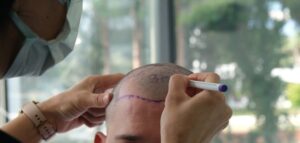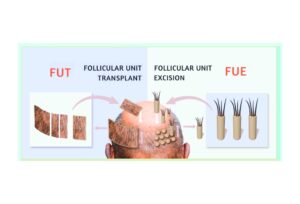Dr. Robert Glyn Jones’ involvement in the field of hair transplantation is a natural outgrowth of his pre-eminence and vast experience in cosmetic surgery, a field that involves fine expertise aimed at achieving natural, seamless results. Dr. Jones provides patients with the defining standard in hair restoration: an undetectable, natural look.
A hair transplant is quite a simple procedure in principle.
1. Why Dr. Robert Jones M.D.?
Dr. Robert Glyn Jones’ involvement in the field of hair transplantation is a natural outgrowth of his pre-eminence and vast experience in cosmetic surgery, a field that involves fine expertise aimed at achieving natural, seamless results. Dr. Jones provides patients with the defining standard in hair restoration: an undetectable, natural look. Dr. Jones is among the first doctors in North America to use a new technique for the transplantation of individual hair follicles. This new approach takes hair transplantation to new levels of precision and artistry since the pattern and direction of each new hair can be controlled.
“Moving hair on someone’s head, from one location to another, is not terribly difficult work,” comments Dr. Jones. “The art – the finely executed expertise – comes from very carefully styling the individual’s look according to what is natural for their overall appearance. Regrettably, a number of people offering hair transplantation fail at this, meaning the patient receives unsatisfactory results. But the craft and attention to detail I’ve perfected, as a physician dedicated to full-time hair transplants, provides my hair transplantation patients with a true benchmark of excellence.”
Dr. Jones is a member of the International Society of Hair Restoration Surgery and has had articles about his practice and new techniques in newspapers and on other hair restoration websites. He has been featured on CBC TV, Canada AM, CTV news and other local television stations to discuss his state-of-the-art approach to hair restoration. See the videos page for hair transplants, interviews and explanations.
Clearly, Dr. Jones is a professional whose dedication to providing value is foremost. Schooled at McMaster University’s Department of Medicine, he has been practising medicine since 1979. He took courses in cosmetic laser surgery at both Harvard and Loyola Universities. His medical milestones include being the first doctor in Canada to use the Argon-pumped tunable dye laser system for treatment of facial veins and PWS, as well as being the first to perform laser-assisted uvulopalatoplasty (he has now carried out over 2,000 procedures). Dr. Jones is also Canada’s first doctor to use the double frequency Q-switched YAG laser (with more than 5,000 operations to his credit) and one of the first to use the UltraPulse CO-2 laser for treating wrinkles.
“Advancing to new medical frontiers has always guided my approach in medicine”, explains Rob. “I am committed to analyzing optimized procedures and techniques that provide real benefits to my patients. That means a combination of the newest equipment plus adopting innovative techniques from medical seminars and journals. The research never stops.”
2. What is a hair transplant exactly?
Hair transplantation is an artistic redistribution system that takes donor dominant hair follicles from donor areas such as the chest or from the very back of the head and artfully transplants them into thinning or balding areas. With current microsurgical technologies, this results in a very natural appearance. Basically, we take hair from where you have more than you need and put it where you need it more.
3. How long does the transplanted hair last?
Since the hair used in hair restoration surgery comes from the donor area, which is not sensitive to the balding process, it will be permanent. This hair will retain its genetic characteristics even after relocation, so for the vast majority of patients, virtually all transplanted hair lasts a lifetime. In some cases, a small percentage of transplanted hair may be lost as the patient ages.
4. What is “follicular unit extraction”?
This procedure has been called the logical endpoint of 30 years of evolution in hair transplantation, beginning with traditional larger plugs and culminating in the move to one, two, three, and four hair follicular unit hair grafts, which mirror the way hair grows in nature. Using this advanced technique, a surgeon can move more hair in a totally natural way – creating a natural look at every stage of hair transplantation.
5. How many hairs are transplanted per session?
Dr. Jones can do up to 2000 microscopically-created grafts in a session. Each graft is an individual hair follicle or can include up to 4 hairs.
6. Does Dr. Jones create his own graft incisions?
Yes. Dr. Jones takes great care in determining the pattern and direction of each transplanted hair.
7. Is it going to hurt?
The great majority of our patients are quite comfortable, both during and after their hair transplantation procedure; occasionally, a patient says he had some pain. As you would expect, local anaesthetics are used during the procedure. We also supply you with medication which is available for you to use after the procedure if you should need it. Many of our patients find that they do not need to take any medication at all after their hair transplantation procedure.
8. Why come to Dr. Jones’ clinic?
There are at least four good reasons why we believe you might be well-advised to have your hair restoration performed at Dr. Jones’ clinic
Reason 1 All transplants are performed personally by Dr. Jones. Many other commercial operations have salespeople and several doctors that come in on a part-time basis to perform your procedure. At my clinic, I will be involved in every transplant, from beginning to end.
Reason 2 Dr. Jones is among the first physicians in North America to use a new technique. This technique allows the transplantation of individual hairs, which can even be taken from the chest. The technique is micro follicular unit extraction, – scalpel-free hair transplants.
Reason 3 Value. Without salespeople and other levels to pay, the cost of a state-of-the-art transplant is less than you may think.
9. How does your procedure differ from all the others I see advertised?
I can’t fully account for the techniques of others, because I don’t know, exactly, the protocols and variations they use in processing the results they achieve. We can talk to you about my own techniques, which include follicular unit micrografting. This is the most natural way to transplant hair, as it is how it appears in nature. Hairs can be transplanted one by one, with attention given to the exact placement and direction of each hair.
10. Is there any scarring?
Whenever human skin is cut, it always heals by the process called “fibrosis”. This fibrosis (commonly known as scarring) is the skin’s way of healing. The healing sites in the transplanted areas are usually so small that the fibrosis is virtually undetectable. At my clinic, hair transplantation procedures are designed to produce a very natural look. In the great majority of cases, the microtechnologies currently used at my clinic make the restored hairline virtually undetectable.
11. Do you offer Rogaine and Propecia? How effective are they?
The manufacturers of both Rogaine and Propecia tell you that their product is not effective in the frontal area, which is the area of most concern to most patients, especially the frontal hairline. With Rogaine, the manufacturer (Upjohn) claims that approximately 8-10% get cosmetically- effective growth, and another 20% get vellus or peach fuzz growth. The manufacturer of Propecia (Merck) claims slightly better results.
12. Why don’t other hair transplants I’ve seen look natural?
Today, if you see a recently-completed hair transplant that does not look natural, that’s because it is usually simply a bad hair transplant. My hair transplants go unnoticed by you and everyone else, in the great majority of cases, because they are so natural looking. Modern research in hair growth has discovered that natural scalp hairs actually grow in small groupings (called follicular units) of 1, 2, 3 or occasionally, 4 hairs per unit. So, it is my strong emphasis not just to imitate nature, but to try to duplicate nature. We employ micro-technologies that use closely-placed and randomly dispersed 1, 2, 3, and 4 hair units. I have refined these micro-technologies to the point where often, other medical doctors, even on close inspection, have a difficult time telling which natural hairs are original (non-transplanted) and which natural hairs have been restored (transplanted). That’s why today, the state-of-the-art is follicular unit extraction.
13. Are there any complications or risks with the hair transplant surgery?
Occurrences of infection after the procedure are rare. In the few cases where infection does occur, it is often due to the patient’s failure to fully follow post-operative instructions. Even when infection occurs, it generally is easily treatable with antibiotics, which can be prescribed by the physician.
14. How many grafts will it take to cover 1 square inch?
That is very difficult to answer without seeing you. This is because the number of grafts required will ultimately be dependant upon the texture and quality of your hair (i.e. darker, coarser hair may require fewer grafts to cover the same area, as compared to lighter coloured, fine hair). It will also be dependent upon your density goals.
15. Do you use a laser in the hair transplantation procedure?
No. I do not feel that the laser benefits the patient. It can damage healthy hair follicles, have a negative impact on scalp elasticity, and in general, slow down the healing process. The use of lasers in hair restoration has diminished greatly in the last few years.
16. Do you do hair transplantation on women?
Yes. Female hair loss is quite common. In fact, studies indicate more than 20 million American women are experiencing some degrees of female pattern hair loss. “The great majority of women with typical female pattern hair loss can be helped significantly. Women usually have a similar donor area to men. This means they have enough supply to fulfil the demand, so the results are usually very good”.
17. I have a medical condition, can I still receive a hair transplant?
Pre-existing medical conditions are always a concern of mine. If you have a pre-existing medical condition, please tell me at the time of your consultation. For your convenience, we have listed responses from some of the most frequently asked medical questions:
COUMADIN If you are taking Coumadin, you will need to be off Coumadin for a week prior to your hair restoration procedure.
DIABETES I have performed a lot of successful hair restoration procedures for patients with diabetes.
INTRAVENOUS SEDATION Intravenous sedation is virtually never used for hair restoration procedures. Instead, patients are gently administered local anaesthesia and are able to relax and stretch, or use the restroom at any time during the procedure. If you would like additional sedation or relaxation, you may request it.
KIDNEY TRANSPLANT For various medical reasons, a hair restoration procedure cannot be done prior to a pending kidney transplant. However, once a kidney transplant procedure is completed and has healed, I can determine if it is feasible to have a hair restoration procedure.

















